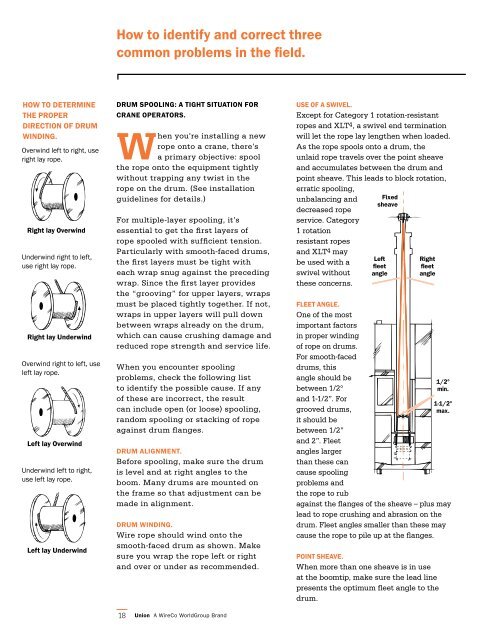Crane User's Guide - Union Wire Rope
Crane User's Guide - Union Wire Rope
Crane User's Guide - Union Wire Rope
You also want an ePaper? Increase the reach of your titles
YUMPU automatically turns print PDFs into web optimized ePapers that Google loves.
how to determine<br />
the ProPer<br />
direCtion of drUm<br />
winding.<br />
Overwind left to right, use<br />
right lay rope .<br />
right lay overwind<br />
Underwind right to left,<br />
use right lay rope .<br />
right lay Underwind<br />
Overwind right to left, use<br />
left lay rope .<br />
left lay overwind<br />
Underwind left to right,<br />
use left lay rope .<br />
left lay Underwind<br />
how to identify and correct three<br />
common problems in the field.<br />
drUm sPooling: a tight sitUation for<br />
<strong>Crane</strong> oPerators.<br />
When you’re installing a new<br />
rope onto a crane, there’s<br />
a primary objective: spool<br />
the rope onto the equipment tightly<br />
without trapping any twist in the<br />
rope on the drum. (See installation<br />
guidelines for details.)<br />
For multiple-layer spooling, it’s<br />
essential to get the first layers of<br />
rope spooled with sufficient tension.<br />
Particularly with smooth-faced drums,<br />
the first layers must be tight with<br />
each wrap snug against the preceding<br />
wrap. Since the first layer provides<br />
the “grooving” for upper layers, wraps<br />
must be placed tightly together. If not,<br />
wraps in upper layers will pull down<br />
between wraps already on the drum,<br />
which can cause crushing damage and<br />
reduced rope strength and service life.<br />
When you encounter spooling<br />
problems, check the following list<br />
to identify the possible cause. If any<br />
of these are incorrect, the result<br />
can include open (or loose) spooling,<br />
random spooling or stacking of rope<br />
against drum flanges.<br />
drUm alignment.<br />
Before spooling, make sure the drum<br />
is level and at right angles to the<br />
boom. Many drums are mounted on<br />
the frame so that adjustment can be<br />
made in alignment.<br />
drUm winding.<br />
<strong>Wire</strong> rope should wind onto the<br />
smooth-faced drum as shown. Make<br />
sure you wrap the rope left or right<br />
and over or under as recommended.<br />
18<br />
Use of a swivel.<br />
Except for Category 1 rotation-resistant<br />
ropes and XLT 4, a swivel end termination<br />
will let the rope lay lengthen when loaded.<br />
As the rope spools onto a drum, the<br />
unlaid rope travels over the point sheave<br />
and accumulates between the drum and<br />
point sheave. This leads to block rotation,<br />
erratic spooling,<br />
unbalancing and<br />
decreased rope<br />
service. Category<br />
1 rotation<br />
resistant ropes<br />
and XLT 4 may<br />
be used with a<br />
swivel without<br />
these concerns.<br />
fleet angle.<br />
One of the most<br />
important factors<br />
in proper winding<br />
of rope on drums.<br />
For smooth-faced<br />
drums, this<br />
angle should be<br />
between 1/2°<br />
and 1-1/2”. For<br />
grooved drums,<br />
it should be<br />
between 1/2”<br />
and 2”. Fleet<br />
angles larger<br />
than these can<br />
cause spooling<br />
problems and<br />
the rope to rub<br />
against the flanges of the sheave – plus may<br />
lead to rope crushing and abrasion on the<br />
drum. Fleet angles smaller than these may<br />
cause the rope to pile up at the flanges.<br />
Point sheave.<br />
When more than one sheave is in use<br />
at the boomtip, make sure the lead line<br />
presents the optimum fleet angle to the<br />
drum.


